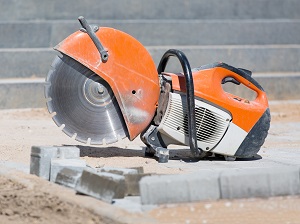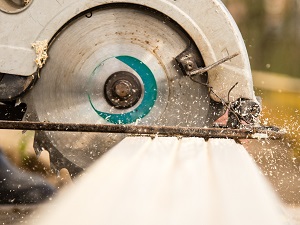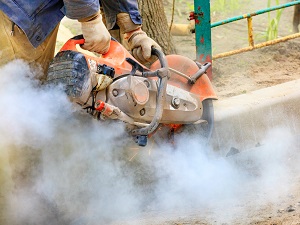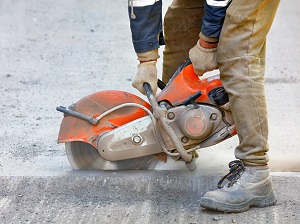There are many different types of handheld, portable power saws, in a variety of sizes, that might be in use on any construction site. These versatile, convenient tools can be dangerous if safety precautions are not taken seriously. Anyone operating a handheld power saw on site must be trained and authorized before use.
OSHA Standard 1926.300(a) All hand and power tools and similar equipment, whether furnished by the employer or the employee, shall be maintained in a safe condition.
Always wear proper PPE when operating any handheld power saw. Wear eye protection, preferably goggles or safety glasses with side protection, and depending on the task, face protection may be recommended as well. Wear closed-toed work shoes, with a good tread, for stability. Dust masks and hearing protection may also be recommended.

When using a handheld power saw, kickback can occur whenever the blade stops suddenly by binding up, jamming or hitting a foreign object. Saw blades build up tremendous kinetic energy during cutting and when they stop suddenly the energy must go somewhere which can cause the blade to strike the operator or cause the operator to drop the saw on their legs or feet.
To minimize the risk of injury due to kickback, the operator must take all precautions to prevent the blade from stopping without warning and reduce the chance of being struck if the saw does stop suddenly.
- Do not use a power saw that is too heavy for you to lift and control.
- Ensure the saw blade is clean and sharp. Dull blades or blades sticky with sap or other materials are more likely to bind up in cuts.
- Always use the proper blade for the material being cut and maintain sharp blades.
- Do not stand directly behind the saw and do not lean into the cut to reduce the chance of being struck in the event of kickback. Maintain your balance and footing at all times.
- Never allow the blade to overheat.
- Do not make off-center or crooked cuts, only cut in straight lines.
- Remove cracked or damaged saw blades from service.

When using any power saw, but especially with handheld circular saws, there is an even greater risk of operator contact with the turning blade.
Portable circular saws must have an upper guard that covers the entire blade of the saw and a retractable lower guard. NEVER alter the lower guard by tying or wedging it open.
OSHA Standard 1926.304(d) Guarding. All portable, power-driven circular saws shall be equipped with guards above and below the base plate or shoe. The upper guard shall cover the saw to the depth of the teeth, except for the minimum arc required to permit the base to be tilted for bevel cuts. The lower guard shall cover the saw to the depth of the teeth, except for the minimum arc required to allow proper retraction and contact with the work. When the tool is withdrawn from the work, the lower guard shall automatically and instantly return to the covering position.
Handheld circular saws with blades greater than one-fourth inch must be equipped with a constant-pressure control. Set the cutting depth as shallow as you can and don’t allow the blade to protrude more than a little below the stock being cut.
Always wait for the blade to stop moving before setting the saw down on your work surface. Only change blades when the saw is disconnected from the power source. When changing the blade, make sure you can see and control the plug so no one else plugs it in, or put the plug in a plastic lock box.

Using a handheld power saw to cut masonry, concrete, stone, or other silica-containing materials can generate respirable crystalline silica dust. When inhaled, the small particles of silica can irreversibly damage the lungs.
Many handheld power saws come equipped with an integrated water delivery system designed to cool the blade by directing a continuous stream of water onto the blade where it wets the material being cut and reduces the amount of dust generated when cutting. Water can be supplied to the saw by either a pressurized container or by a constant water supply such as a hose connected to a faucet or construction site water supply. Water flow must be sufficient to minimize release of visible dust.
OSHA Standard 1926.1153(c)(1) Table1 provides specified exposure control methods when working with materials containing crystalline silica.
The power saw, and the saw’s dust-control equipment, must be operated and maintained in accordance with manufacturer’s instructions to minimize dust emissions. Check that hoses are securely connected and are not cracked or broken. Adjust nozzles so that water goes to the blade and wets the cutting area. Inspect the saw blade before use to be sure it is in good condition and does not show excessive wear.
Clean up any slurry produced during wet cutting to prevent the slurry from drying and releasing silica dust into the air. Wet slurry can be cleaned up using shovels or a vacuum equipped with a HEPA filter.

Wet cutting indoors or in enclosed areas may not reliably keep silica exposures low, so extra ventilation or a means of exhaust may be needed to reduce visible airborne dust. Extra ventilation can be supplied by using:
- Exhaust trunks
- Portable exhaust fans
- Air ducts
- Other means of mechanical ventilation
Ensure air flow is not impeded by the movements of employees during work, or by the opening or closing of doors and windows. Position the ventilation to move contaminated air away from the workers’ breathing zones.
Where water is used to control dust, electrical safety is a particular concern. Use ground-fault circuit interrupters (GFCIs) and watertight, sealable electrical connectors for electric tools and equipment.
In addition to using wet cutting methods, respiratory protection with a minimum Assigned Protection Factor (APF) of 10 is required when wet cutting with handheld masonry saws indoors or in an enclosed area or used outdoors for more than four hours per shift.


